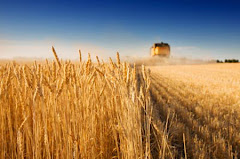Wheat futures have been riding high over the last four weeks, but that seems about to end, even though weather conditions in Canada and Russia continue to cause problems for the grain.
The challenge for wheat, as it has been for years, is the increasing amount of acreage around the world being dedicated to growing the grain.
With that in mind, the inevitable bad weather in various parts of the world, while having a temporary impact on wheat futures' prices, overall level off and bring them back down to where they belong.
Until there is a move toward planting less wheat, which is unlikely any time soon, this will remain the way things are.
Heading into August, wheat futures will drop down to about $5 a bushel, or even lower.
Friday, July 23, 2010
Saturday, July 3, 2010
Toxins Cutting into Wheat Income in Ohio
Higher than normal level of toxins are slashing the income of some farmers in Ohio.
According to representatives of the Ohio State University Extension Service, vomitoxin levels are the worst in seven to ten years in some areas of the state, especially areas where it's cooler and wet.
A wet May in particular produced conditions for the fungus to thrive.
The high levels of toxins limit the use of wheat for people, and also in livestock, especially pigs, which could cause a lot of problems in them.
According to representatives of the Ohio State University Extension Service, vomitoxin levels are the worst in seven to ten years in some areas of the state, especially areas where it's cooler and wet.
A wet May in particular produced conditions for the fungus to thrive.
The high levels of toxins limit the use of wheat for people, and also in livestock, especially pigs, which could cause a lot of problems in them.
Friday, July 2, 2010
Wheat Prices Could Keep Declining, Says Commonwealth Bank of Australia
After the largest gain in over four months, wheat futures in Chicago fell again, and according to the Commonwealth Bank of Australia, wheat prices could continue falling.
“The global economic recovery is looking increasingly unstable,” Commonwealth Bank of Australia said in a note to clients today. “U.S. harvest pressure also remains a risk” and wheat prices could keep declining.
Wheat farmers in the U.S. planted about 13.907 million acres of spring wheat, an increase of 4.8 percent from 2009, according to the U.S. Department of Agriculture.
Including all wheat varieties, total bushels of wheat inventory as of June first stood at 973 million as of June 1. That's up from 657 million last year.
We've been wondering out loud at Wheat Wise for some time why farmers continue to do this. Why continue to plant wheat under these conditions? Why not change to crops with better potential returns and margins? How hard is that to understand?
Wheat farmers must understand that an enormous amount of wheat is being planted in countries that did very little wheat sowing in the past, and add to that the increased amount in the U.S. and there's not going to be a good price any time in the near future.
“The global economic recovery is looking increasingly unstable,” Commonwealth Bank of Australia said in a note to clients today. “U.S. harvest pressure also remains a risk” and wheat prices could keep declining.
Wheat farmers in the U.S. planted about 13.907 million acres of spring wheat, an increase of 4.8 percent from 2009, according to the U.S. Department of Agriculture.
Including all wheat varieties, total bushels of wheat inventory as of June first stood at 973 million as of June 1. That's up from 657 million last year.
We've been wondering out loud at Wheat Wise for some time why farmers continue to do this. Why continue to plant wheat under these conditions? Why not change to crops with better potential returns and margins? How hard is that to understand?
Wheat farmers must understand that an enormous amount of wheat is being planted in countries that did very little wheat sowing in the past, and add to that the increased amount in the U.S. and there's not going to be a good price any time in the near future.
Labels:
Wheat Acreage Planted,
Wheat Prices
Thursday, July 1, 2010
South Dakota Winter, Spring Wheat Plantings Down
Winter wheat acreage planted in fall 2009 in South Dakota was down 26 percent from the year before, coming to a total of 1.25 million acres, a major decline from the 1.70 million acres in 2008.
Of those acres expected to be for harvest, as of conditions on June 1, 1.18 million should be harvested, a decrease of 350,000 last year. That's 23 percent down from the 1.53 million harvested the year before.
Spring wheat plants came in at 1.4 million acres, dropping 7 percent, or 100,000 acres from 2009. Of those, 1.37 million acres were meant for harvest, also down 7 percent.
Plantings of durum wheat stood at 10,000 acres, and increase of 1,000 over last year, with about 9,000 acres of that to be harvested for grain this year.
Of those acres expected to be for harvest, as of conditions on June 1, 1.18 million should be harvested, a decrease of 350,000 last year. That's 23 percent down from the 1.53 million harvested the year before.
Spring wheat plants came in at 1.4 million acres, dropping 7 percent, or 100,000 acres from 2009. Of those, 1.37 million acres were meant for harvest, also down 7 percent.
Plantings of durum wheat stood at 10,000 acres, and increase of 1,000 over last year, with about 9,000 acres of that to be harvested for grain this year.
Labels:
Durum,
Spring Wheat Planting,
Winter Wheat
Subscribe to:
Comments (Atom)
